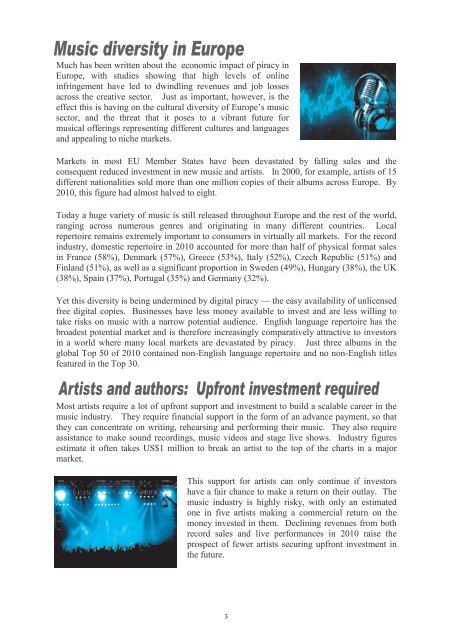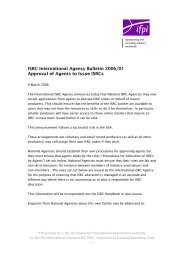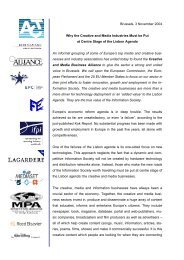Impact of Piracy on Cultural Diversity of European Music - IFPI
Impact of Piracy on Cultural Diversity of European Music - IFPI
Impact of Piracy on Cultural Diversity of European Music - IFPI
Create successful ePaper yourself
Turn your PDF publications into a flip-book with our unique Google optimized e-Paper software.
Much has been written about the ec<strong>on</strong>omic impact <str<strong>on</strong>g>of</str<strong>on</strong>g> piracy in<br />
Europe, with studies showing that high levels <str<strong>on</strong>g>of</str<strong>on</strong>g> <strong>on</strong>line<br />
infringement have led to dwindling revenues and job losses<br />
across the creative sector. Just as important, however, is the<br />
effect this is having <strong>on</strong> the cultural diversity <str<strong>on</strong>g>of</str<strong>on</strong>g> Europe’s music<br />
sector, and the threat that it poses to a vibrant future for<br />
musical <str<strong>on</strong>g>of</str<strong>on</strong>g>ferings representing different cultures and languages<br />
and appealing to niche markets.<br />
Markets in most EU Member States have been devastated by falling sales and the<br />
c<strong>on</strong>sequent reduced investment in new music and artists. In 2000, for example, artists <str<strong>on</strong>g>of</str<strong>on</strong>g> 15<br />
different nati<strong>on</strong>alities sold more than <strong>on</strong>e milli<strong>on</strong> copies <str<strong>on</strong>g>of</str<strong>on</strong>g> their albums across Europe. By<br />
2010, this figure had almost halved to eight.<br />
Today a huge variety <str<strong>on</strong>g>of</str<strong>on</strong>g> music is still released throughout Europe and the rest <str<strong>on</strong>g>of</str<strong>on</strong>g> the world,<br />
ranging across numerous genres and originating in many different countries. Local<br />
repertoire remains extremely important to c<strong>on</strong>sumers in virtually all markets. For the record<br />
industry, domestic repertoire in 2010 accounted for more than half <str<strong>on</strong>g>of</str<strong>on</strong>g> physical format sales<br />
in France (58%), Denmark (57%), Greece (53%), Italy (52%), Czech Republic (51%) and<br />
Finland (51%), as well as a significant proporti<strong>on</strong> in Sweden (49%), Hungary (38%), the UK<br />
(38%), Spain (37%), Portugal (35%) and Germany (32%).<br />
Yet this diversity is being undermined by digital piracy — the easy availability <str<strong>on</strong>g>of</str<strong>on</strong>g> unlicensed<br />
free digital copies. Businesses have less m<strong>on</strong>ey available to invest and are less willing to<br />
take risks <strong>on</strong> music with a narrow potential audience. English language repertoire has the<br />
broadest potential market and is therefore increasingly comparatively attractive to investors<br />
in a world where many local markets are devastated by piracy. Just three albums in the<br />
global Top 50 <str<strong>on</strong>g>of</str<strong>on</strong>g> 2010 c<strong>on</strong>tained n<strong>on</strong>-English language repertoire and no n<strong>on</strong>-English titles<br />
featured in the Top 30.<br />
Most artists require a lot <str<strong>on</strong>g>of</str<strong>on</strong>g> upfr<strong>on</strong>t support and investment to build a scalable career in the<br />
music industry. They require financial support in the form <str<strong>on</strong>g>of</str<strong>on</strong>g> an advance payment, so that<br />
they can c<strong>on</strong>centrate <strong>on</strong> writing, rehearsing and performing their music. They also require<br />
assistance to make sound recordings, music videos and stage live shows. Industry figures<br />
estimate it <str<strong>on</strong>g>of</str<strong>on</strong>g>ten takes US$1 milli<strong>on</strong> to break an artist to the top <str<strong>on</strong>g>of</str<strong>on</strong>g> the charts in a major<br />
market.<br />
This support for artists can <strong>on</strong>ly c<strong>on</strong>tinue if investors<br />
have a fair chance to make a return <strong>on</strong> their outlay. The<br />
music industry is highly risky, with <strong>on</strong>ly an estimated<br />
<strong>on</strong>e in five artists making a commercial return <strong>on</strong> the<br />
m<strong>on</strong>ey invested in them. Declining revenues from both<br />
record sales and live performances in 2010 raise the<br />
prospect <str<strong>on</strong>g>of</str<strong>on</strong>g> fewer artists securing upfr<strong>on</strong>t investment in<br />
the future.<br />
3

















